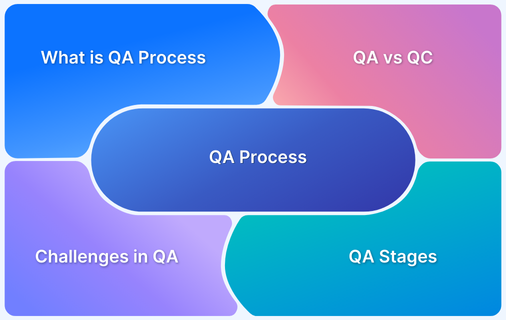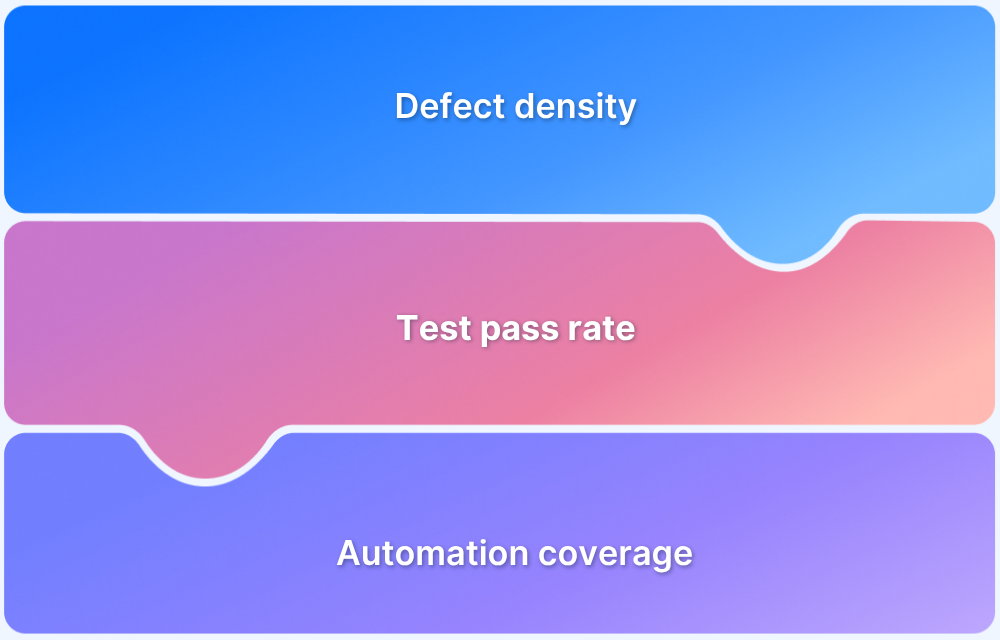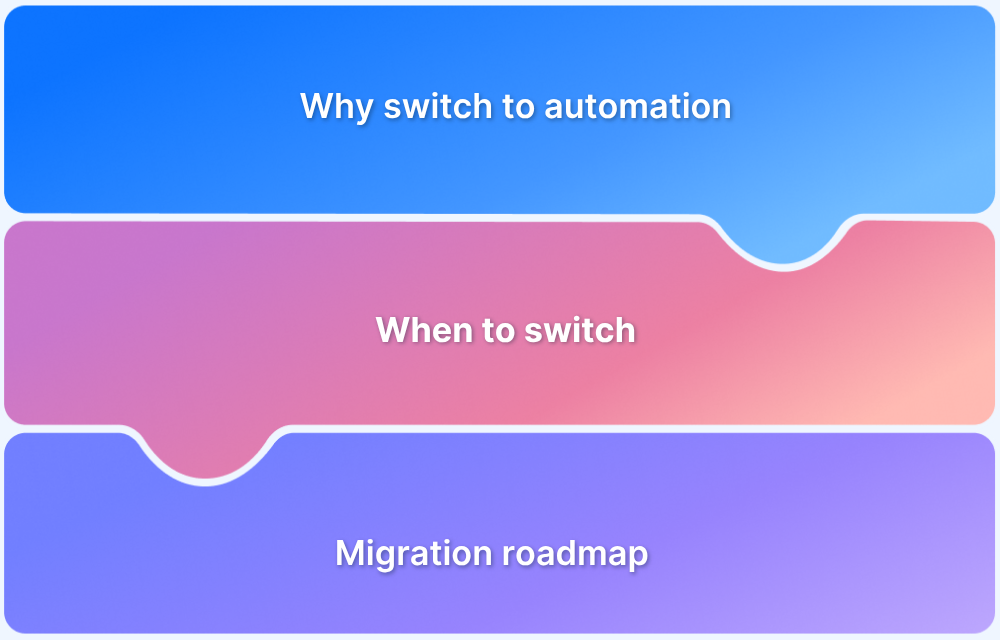An effective Quality Assurance (QA) team ensures product reliability, performance, and consistency by identifying and addressing potential issues before they reach end users.
Training and managing a QA team begins by defining clear goals and equipping the team with the necessary tools and processes. Additionally, promote continuous learning and feedback to help your team stay current with evolving industry standards and sharpen their skills.
Learn how to train, engage, and manage your Quality Assurance (QA) team in detail in this guide.
QA Training
Training equips testers with the skills and knowledge necessary to identify defects, improve test coverage, and ensure that quality standards are met.
Train your QA team by:
- Establishing clear objectives
- Training on core tools and processes
- Prioritizing real-world testing scenarios
- Encouraging continuous learning
- Offering mentorship & feedback
Here’s an in-depth breakdown of these strategies.
- Establish clear objectives: Set specific, measurable goals for the team, covering both technical skills (e.g., tools, methodologies) and quality benchmarks (e.g., test coverage, defect detection).
- Train on core tools & processes: Introduce testers to essential tools and testing methodologies. Offer hands-on training with the tools your team uses daily (e.g., test management software, automation frameworks) and provide an overview of your team’s workflows and best practices.
- Prioritize real-world testing scenarios: Give testers opportunities to work on live projects to help them apply their knowledge in practical, real-world situations. This boosts confidence and prepares them for the complexities of testing in dynamic environments.
- Encourage continuous learning: Encourage ongoing learning through workshops, courses, and certifications to keep the team up-to-date with new technologies, trends, and testing methodologies. This ensures testers grow and remain adaptable to industry changes.
- Offer Mentorship & feedback: Implement a mentorship program where senior team members guide newcomers. Regular one-on-one feedback sessions foster continuous growth and help testers improve both their technical skills and soft skills.
QA Engagement
A team that feels connected to the overall goals of the project is more likely to deliver quality results and take ownership of their work.
Here’s a quick list of strategies to engage QAs:
- Ask for and incorporate feedback
- Offer challenges
- Explore each tester’s uniqueness
- Involve Testers early on
Below is a detailed breakdown of each of these strategies.
- Ask for and incorporate feedback: No one wants to feel like a cog in a machine. Don’t just instruct testers on what to do. Every project must start with brainstorming sessions of how best to get work done. Each tester must have complete freedom to voice their opinion and be adequately heard by the team and the manager. If their views are incorporated, it makes the QA feel far more valued as a team member.
- Offer challenges: As far as possible, don’t bore testers with repetitive tasks. What’s the point of putting them through extensive training if those skills are not honed with real-world applications? Now it certainly isn’t possible to offer exciting tasks every day, but managers can try to challenge them to brainstorm new ideas or pick up a new tool or test automation framework. Testers operating at advanced levels can also be assigned more complex side projects or be asked to consult for other teams because of their expertise.
- Explore Each Tester’s Uniqueness: Any Quality Assurance manager must be aware of each tester’s unique abilities. When assigning tasks, try to allocate them based on each tester’s realm of expertise. By doing this, testers feel like they are contributing in indispensable ways. It also lets them know what aspects of their knowledge and training is working, and what capabilities they could leverage to further their careers.
- Involve Testers early on: Testers should be part of development sprints cycles from the very first meeting. When they know the intricacies of development early on, they are much better prepared to create test scenarios, test cases, user profiles, and a list of bugs to look for. It also keeps them from remaining unoccupied until developers are done pushing a build.
Read More: Is your QA team ready for Remote Testing?
QA Team Management
Effective QA team management ensures that testing processes run smoothly and product quality is maintained at every stage.
The best strategies for managing a QA team are:
- Communicate with consistency
- Involve Stakeholders in relevant discussions
- Schedule one-on-one time with testers
- Pair technical skill development with soft skills
- Introduce real devices
Below is a detailed explanation of these QA team management strategies.
- Communicate with consistency: Every Quality Assurance manager needs to be able to effectively share feedback and ideas with his team as well as developers working on the software under test. Conflict is natural in such settings, and resolving it can be a QA manager’s worst nightmare. However, managers can make things easier by creating a team environment in which testers can speak up regularly, share ideas, and have clarity on issues that can affect productivity and effectiveness. They also need to stay open to new management tools and strategies, and device methods to foster cooperation between devs and testers. Outside of the workspace, cordial personal relations with other teams and devs help achieve these to a great extent.
- Involve Stakeholders in relevant discussions: Much like an earlier point about involving testers in development discussions, developers and business stakeholders should be made part of QA conversations. Testers need to understand potential users’ journeys to understand how they will use the software. Business stakeholders are the best people to detail user behavior, which makes QA’s jobs much easier. Greater involvement of non-testing personnel can provide insight into software issues, customer expectations, and other data necessary for testers to work at high levels of efficacy. Use these meetings to gather development findings, customer feedback, possible testing roadblocks, and product history.
- Schedule One on One Time with Testers: Schedule some time every quarter with each individual team member to discuss their performance and goals. Allow testers to reveal what may be impeding their progress, what goals they would like to pursue, and how they see themselves advancing their career. This allows managers to identify what motivates each member, and how they can enable opportunities for team members’ growth.
- Pair technical skill development with soft skills: All the technical skills in the world cannot help QA managers run their team if they do not have a greater purpose in mind. Soft skills, such as communication and relationship-building are what allow leaders to create impact, gain confidence, and exert influence even beyond their team. Managers need to invest time in themselves to find ways to strike this balance. For example, taking a couple of workshops on conflict resolution along with learning why Cypress should be added to the automation testing toolkit.
Read More: Effective Tips for Managing Remote QA Team
- Introduce real devices: The QA manager’s primary job is to get tests accomplished faster without compromising on the accuracy of results. That is impossible to achieve without using real browsers and devices for testing. Whether manual testing or automated Selenium testing, real devices are non-negotiable in the testing equation. The device pool for testing must include not just the latest devices, but also older devices still active in the market. Since one can’t know which device will be used to access a website or app in a highly fragmented landscape, the more devices one can run tests on, the better. It is best for managers to get their entire team on a single test plan for easy collaboration with BrowserStack’s Live for Large Teams. This tool allows managers to add as many users as they want to a single testing plan. This means that every tester on a team can work on a single plan. Additionally, Live for Large Teams provides the following features:
- Unlimited Users: Add as many users as you like. Give access to as many users as you want at affordable pricing. No need to share accounts.
- Advanced Access Control: Create sub-teams, customize dashboard views, and allocate parallel threads to teams based on their testing needs.
- Single Sign-On: Simplified login experience. Integrate with your existing identity provider for authentication.
- Real Device Access: Every tester on a plan (no matter how many) will be able to test on 2000+ real browsers and real devices. No emulators. Old legacy versions are also available.
- Personal Device Cloud: Instant access from anywhere for every tester on the team. Real-time debugging with integrated dev tools.
- Real user conditions: GPS and IP geolocation(test websites from over 45+ countries), Natural gestures, Screen Orientation
Live for Large Teams allows users to test from anywhere at any time. It is ideal for remote testers because it lets every tester access BrowserStack work from anywhere, collaborate with integrations like Jira, Slack, GitHub, and Trello. With instant access to 2000+ browsers and devices, Dev and QA teams can focus on testing without worrying about device availability.
Users can sign up, select a device-browser-OS combination, and start testing. They can simulate user conditions such as low network and battery, changes in location (both local and global changes), and viewport sizes as well as screen resolutions. To speed up, testers can execute parallel testing on BrowserStack’s cloud Selenium grid.
Try Selenium Testing on Real Device Cloud for Free
Conclusion
Building and managing a successful QA team requires a balanced approach of clear objectives, continuous training, active engagement, and effective management. Focus on three key areas—establishing clear goals, fostering continuous learning, and maintaining strong collaboration.
These strategies will keep your team motivated, skilled, and aligned with the company’s quality standards. Don’t forget to adapt and refine these strategies to fit the unique needs and dynamics of your team.






